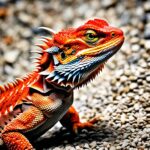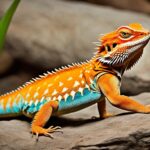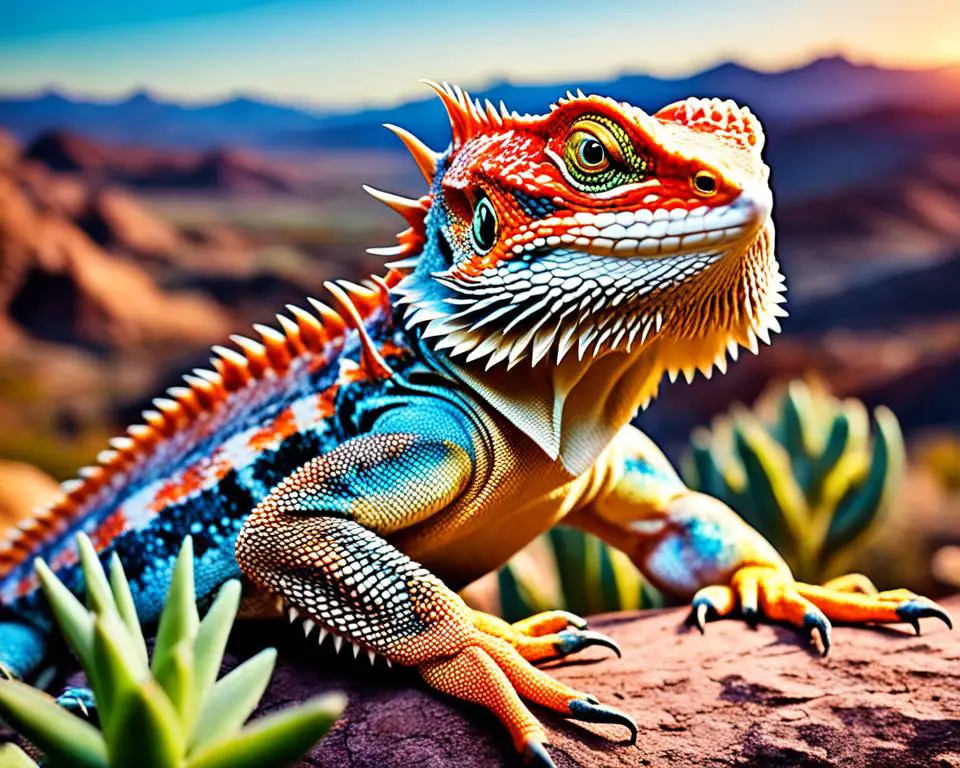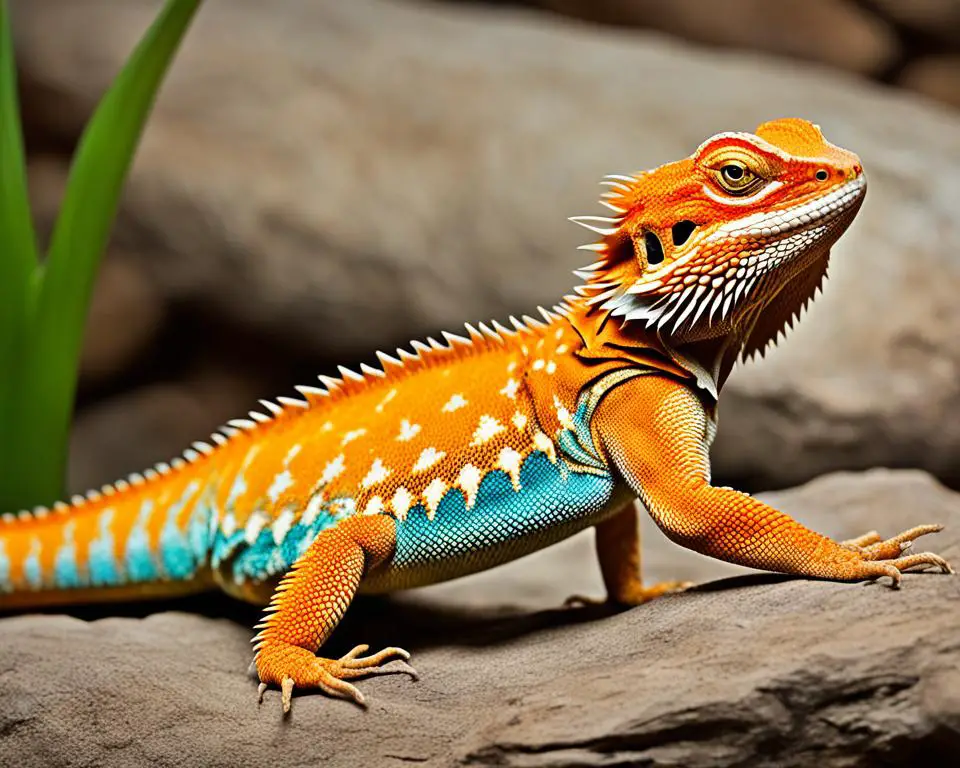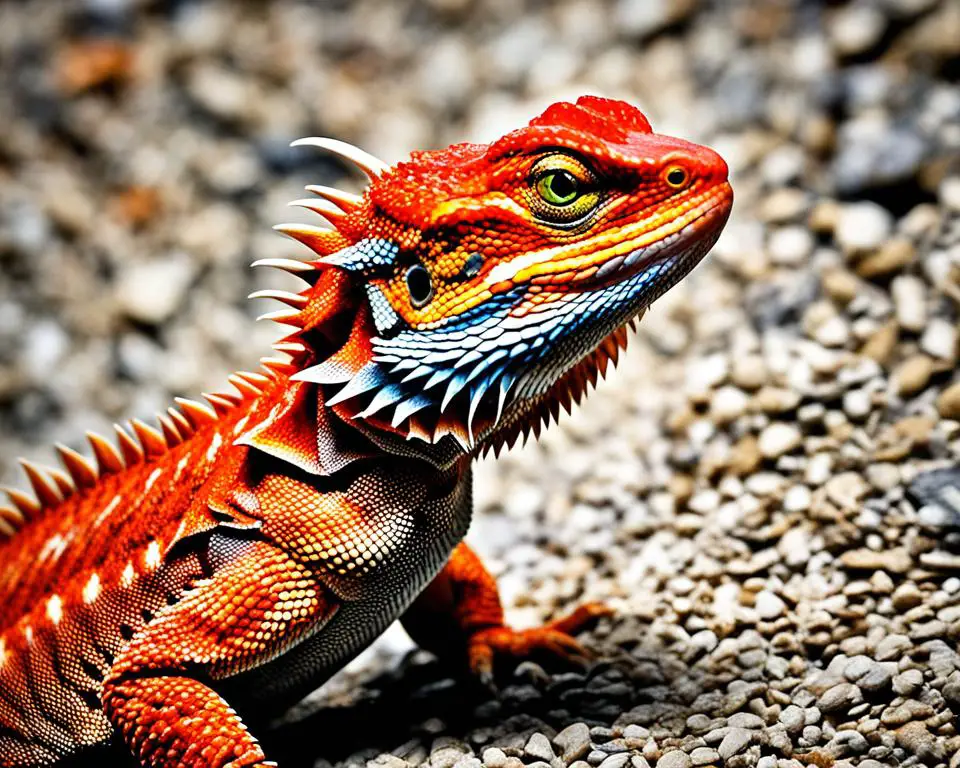The bearded dragon zero is known for its unique white or silver-gray look. It has won the hearts of reptile lovers in the U.S. since the 1990s. These reptiles come in 11 recognized morphs, showing off vibrant colors and patterns.
Zero morph dragons are famous for their striking look. They come in hypo and non-hypo types. These dragons are a big deal in the bearded dragon care world.
But, other morphs like the silkie bring up ethical questions. Silkbacks are loved for their lack of scales but face scrutiny over their lives. Top breeders like 7th Galaxy Dragons and Here B Dragons talk about the need for ethical breeding. The zero morph is a favorite for its unique white to silver-gray color.
If you’re new to bearded dragon care or have been doing it for a while, knowing about zero morph dragons is key. This guide will give you the info you need to care for your white bearded dragon. It will help you ensure a happy and healthy life for your pet.
Introduction to Bearded Dragon Zero Morphs
The world of bearded dragon morphs is full of unique and stunning varieties. The zero morph is a standout, known for its lack of color and pattern. We’ll explore the zero morph‘s history and why it’s so popular.
What is a Bearded Dragon Zero?
A Bearded Dragon Zero is known for its unique look. It comes in hypo zero and non-hypo zero types. Hypo zeros have a paper-white look, while non-hypo zeros can be silver or gray. Their lack of color makes them stand out among bearded dragon morphs.
History and Popularity
The zero morph started in the 1990s in the United States. Back then, keeping bearded dragons as pets was becoming more popular. Breeders have worked hard to develop and improve these morphs over the years.
Reputable breeders like 7th Galaxy Dragons have helped highlight the unique traits of zero morphs. They’ve made sure people know about their special needs. Today, the zero morph is a key part of the bearded dragon world, loved by both enthusiasts and breeders.
This has led to more varieties of hypo and non-hypo zero morphs. It’s made them even more appealing to reptile fans.
Understanding Bearded Dragon Morphs
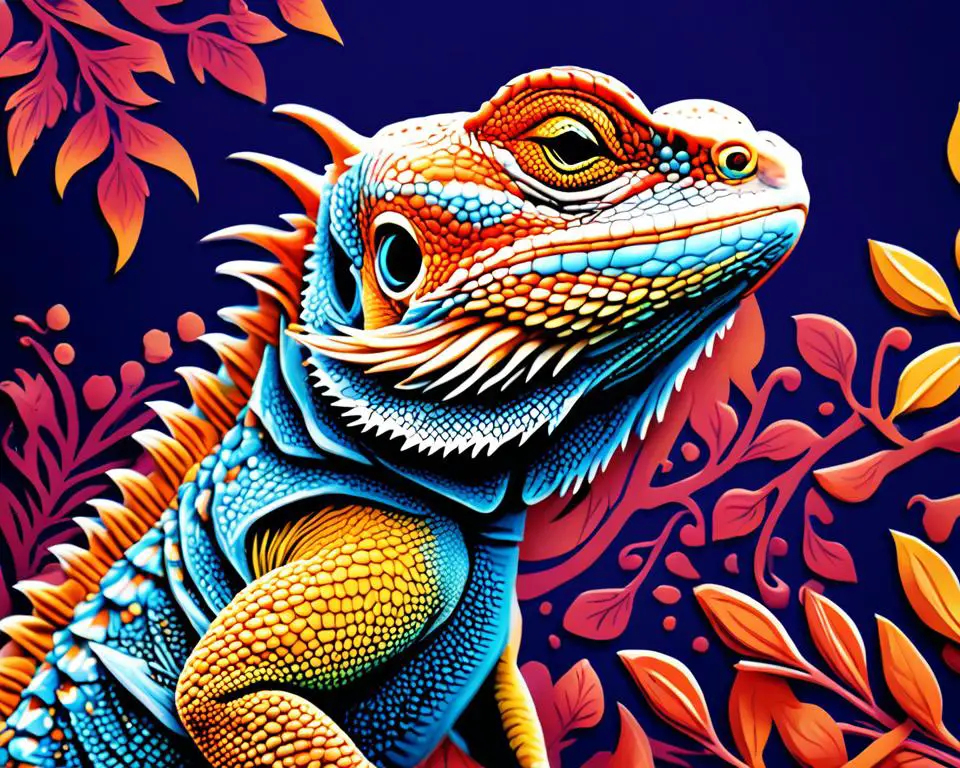
Bearded dragons have many morphs, each with unique traits. These can be split into scaling and visual morphs. This makes it easier to see their differences.
Common Morphs and Their Characteristics
Some morphs are more popular because of their special features. The Standard morph is common, with colors like yellow, brown, or tan. German Giant morphs are big, up to 25-30 inches long.
Leatherback dragons have fewer scales, making them look smoother. The Silkie morph is rare and has no scales, which can make it hard to care for.
Visual vs. Scaling Morphs
Visual morphs change the bearded dragon’s color and pattern. For example, the Translucent morph has see-through scales and black eyes. Hypomelanism (Hypo) morphs make the dragons lighter with clear nails.
Scaling morphs, like the Dunner, change how the scales grow. This creates unique patterns.
Color and Pattern Variations
Bearded dragons can be many colors, from natural shades to bright reds and oranges. Breeders have created rare colors like fire engine red and lemon yellow. The Paradox morph has random, bright patches.
Zero morphs lack all color and pattern, showing a range from white to nearly black. These patterns make bearded dragons unique and sought after.
| Morph | Characteristics | Commonality |
|---|---|---|
| Standard | Yellow, brown, or tan color; rigid, rubbery scales. | Common |
| German Giant | Up to 25-30 inches long; significantly larger. | Less Common |
| Leatherback | Smoother appearance due to reduced scales. | Common |
| Silkie | Scaleless, prone to injury; needs special care. | Rare |
| Hypo | Lighter color; clear nails due to reduced melanin. | Less Common |
| Translucent | Partially see-through skin; solid black eyes. | Less Common |
| Paradox | Random, vibrant patches; unique patterns. | Rare |
| Zero | Eliminates all color and patterns. | Rare |
Specific Care Requirements for Bearded Dragon Zero
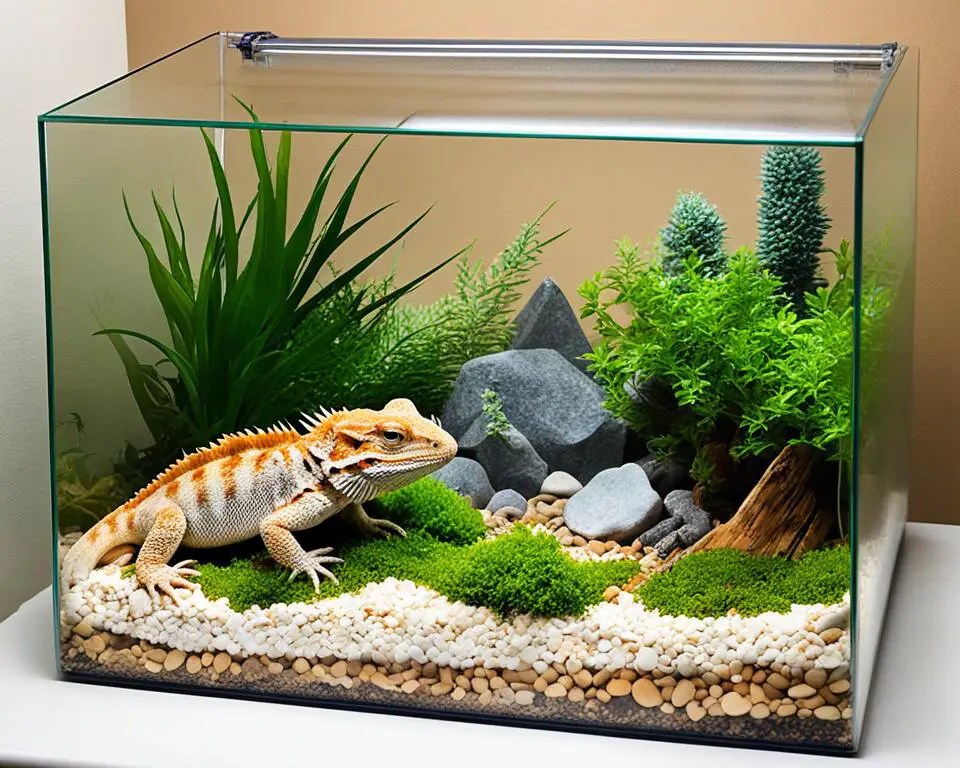
Setting up a proper bearded dragon habitat is key to their care. A well-sized reptile enclosure is vital for their health and happiness.
Habitat Setup and Tank Conditions
Use a glass or plexiglass terrarium for the bearded dragon habitat. It should have full-spectrum lighting to mimic their natural environment. This helps with their behavior and health.
- Tank Size: Juvenile dragons need a tank of 80x50x50 cm (32x20x20 in). Adults should have a 120x50x50 cm (48x20x20 in) tank. For multiple adults, go for a 150x50x50 cm (59x20x20 in) enclosure.
- Temperature Gradient: The basking spot should be between 95°F and 110°F. The cool end should be around 85°F for thermoregulation.
- UVB Lighting: A UVB light that covers about 30 cm (12 in) is crucial to prevent metabolic bone disease.
Substrate Options
Choosing the right substrate is important for your dragon’s health and cleanliness. Avoid loose sand as it can be harmful if ingested.
| Substrate | Pros | Cons |
|---|---|---|
| Reptile Carpet | Easy to clean; reduces ingestion risk | Needs regular replacement; can house bacteria if not cleaned |
| Paper-based Solution | Highly absorbent; safe if ingested | Less aesthetic; needs frequent changing |
Keeping a bearded dragon’s habitat healthy is crucial. By following these guidelines and choosing safe substrates, you’ll help your bearded dragon zero thrive.
Bearded Dragon Zero Diet and Feeding
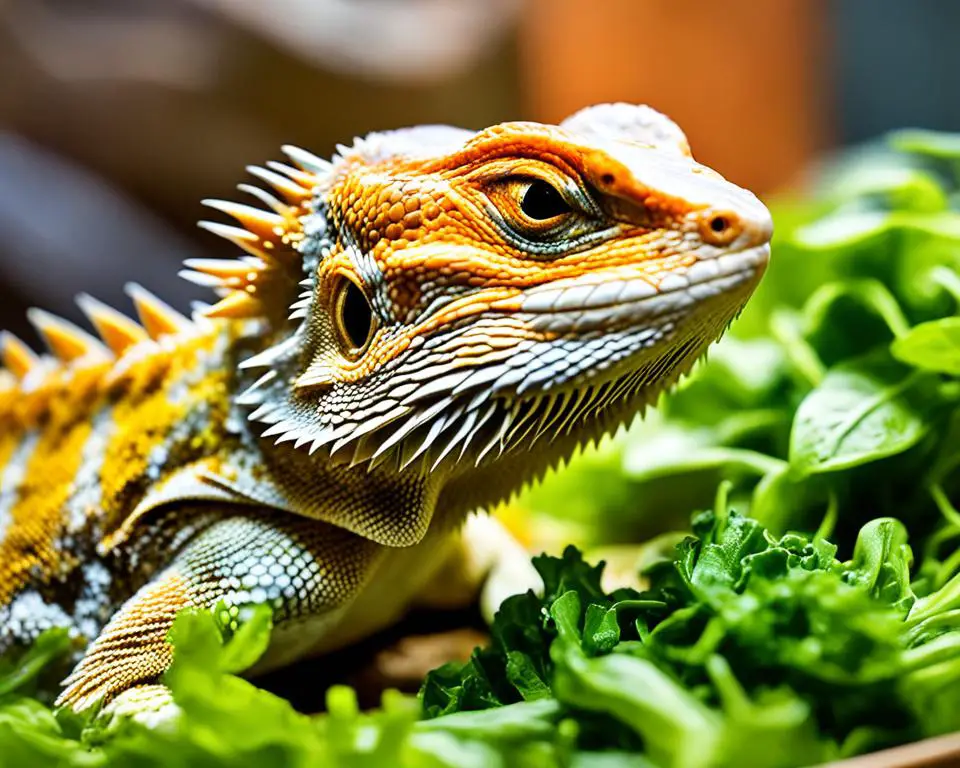
The diet of a Bearded Dragon Zero is key to its health and happiness. They need a mix of insects, vegetables, and supplements for all the vitamins and minerals they need.
Omnivorous Diet: Insects and Vegetables
Bearded Dragon Zeros eat both animals and plants. Young dragons need insects and greens every day. Good insects for them include crickets, calci worms, and Dubia roaches, given several times a week.
As they grow, they eat more greens and vegetables. This keeps them healthy.
- Young Bearded Dragon Zero: About 65% live food (crickets, worms) and 35% greens.
- Older Bearded Dragon Zero (larger than 30 cm): Approximately 40% live food and 60% greens.
They can also have fruits like small apple pieces or berries sometimes. Pinky mice are another good source of protein for them.
Supplements and Nutrition
Nutritional supplements are key for Bearded Dragon Zeros. They help keep them healthy, support bone growth, and boost their energy.
- Calcium: Important for strong bones, dust it on insects or mix with greens every day.
- Vitamin D3: Helps with calcium use, especially if dragons don’t get enough UVB light.
- Multivitamins: A mix of nutrients that supports their overall health.
Use these nutritional supplements on feeder insects and add them to the diet. A good habitat and lighting are also crucial. Keep a warm spot of about 100 degrees Fahrenheit and use full-spectrum UVB lighting for their health.
Health and Common Issues
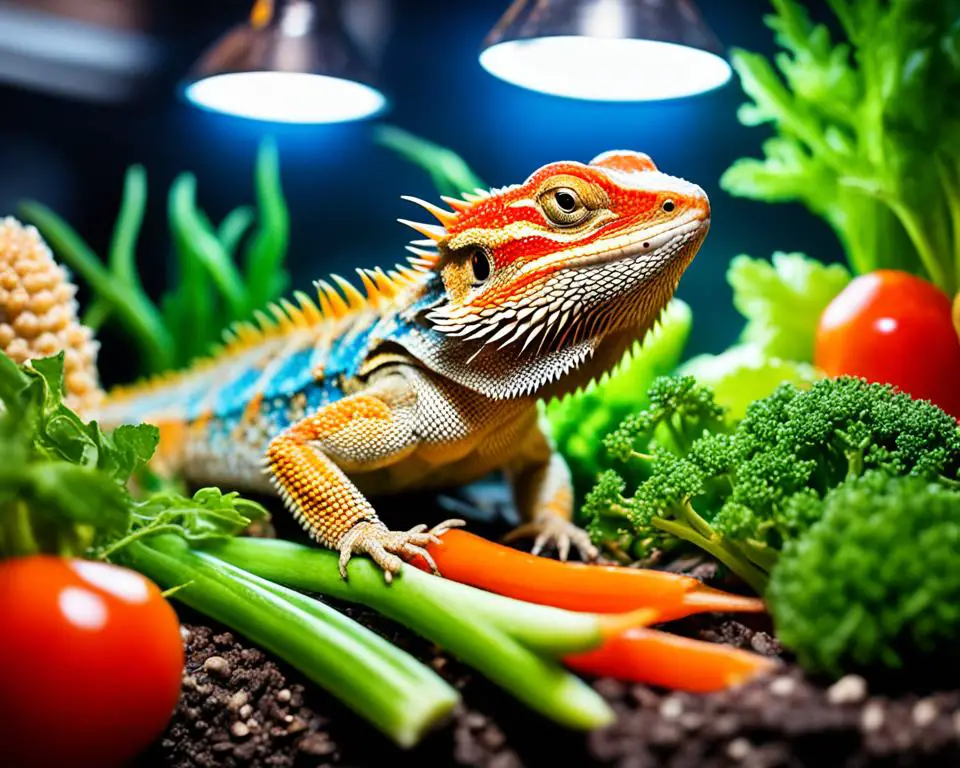
Keeping bearded dragons healthy means paying close attention and acting fast when they get sick. These reptiles face many health problems that can really impact their well-being.
Mouth Rot, Parasites, and Respiratory Infections
Infectious stomatitis, or mouth rot, is a bacterial infection that hits the gums and jawbone of bearded dragons. Watch for swelling, color changes, or spit from the mouth.
Parasites like pinworms, motile protozoa, and coccidia can be found through poop tests. Regular vet visits can stop these parasites from causing big health problems.
Respiratory infections can lead to pneumonia and are caused by bacteria, viruses, fungi, or parasites. They often happen when bearded dragons are stressed or live in poor conditions. Look out for signs like wheezing, runny nose, and being very tired.
Skin Shedding and Brumation
Shedding is normal for bearded dragons but needs watching. Young ones shed often, but this slows down as they get older. Keeping shed skin off is important to avoid problems.
Brumation makes bearded dragons sleep a lot, like hibernation. It lowers their metabolism and activity. Knowing when they should brumate helps avoid thinking it’s an illness.
Regular vet visits, a good diet, and the right tank conditions are key to stopping and treating these common issues. This helps your bearded dragon live a long, healthy life.
Handling and Interaction
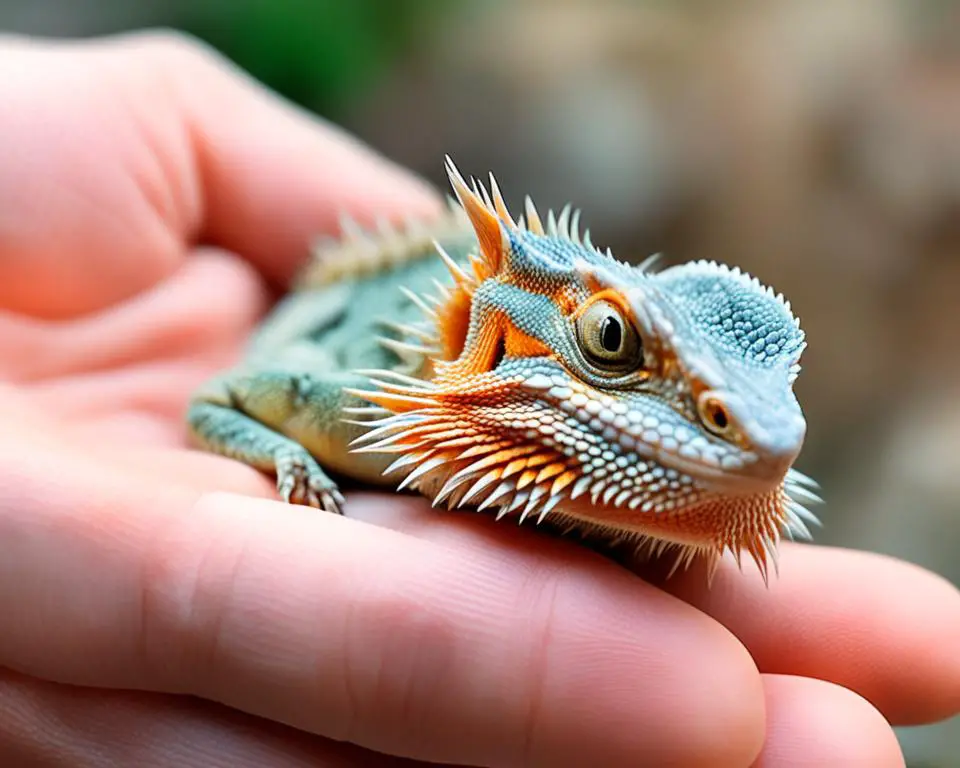
Bearded Dragon Zeros are gentle, making them great for handling if done right. Move slowly and gently to build trust and avoid stress in these trusting reptile pets. Learning how to interact with them properly helps create a strong bond.
Proper Techniques for Safe Handling
When handling bearded dragons, it’s important to handle them safely. Always support their body under the belly and keep their head and tail secure. Don’t make sudden moves that might scare them.
Pet them with the scales facing you to reduce stress. Supporting them well can help lessen anxiety caused by handling.
Building Trust with Your Pet
To build trust, interact with your bearded dragon regularly and thoughtfully. They can bond with humans and show affection, like sitting on your lap or being excited when you come home. They feel secure in their own ways, like sleeping near you or watching TV with you.
Activities that strengthen your bond include feeding them by hand, picking them up gently, and spending time with them. Respect their space and understand their wild nature to bond with your bearded dragon. Gradually get them used to your presence in a calm environment for their well-being.
Good reptile interaction makes your bearded dragon feel safe and comfortable. Mistakes like mishandling or loud noises can break trust. Pay attention to their needs and how they react to improve your relationship.
Enclosure Maintenance and Cleaning
Keeping a bearded dragon’s home clean is key for their health. It stops bacteria from growing and keeps them happy. This guide will show you how to clean your terrarium daily, weekly, and monthly.
Daily and Weekly Cleaning Routines
For a clean bearded dragon home, clean daily. Clean up any poop or leftover food and change the water. This keeps the place clean and stops bacteria from growing.
Every week, do a deeper clean. Clean the water bowls, stir the substrate, and disinfect surfaces. Also, wash decor like logs and plants. Use a mix of 1 part vinegar to 2 parts water to clean safely.
Monthly Deep Clean
Do a deep clean every month. Change the substrate and disinfect everything. Use a steam cleaner if you have one to clean without harsh chemicals. Always wear gloves to protect yourself from germs.
Following these cleaning steps keeps your bearded dragon’s home safe and healthy. It makes sure they live a happy life. And it makes taking care of them more fun for you too.
Cost and Availability
Thinking about getting a bearded dragon zero cost means you’ll need a big budget at first. These dragons start at about $400, thanks to their unique look and special care needs. Finding them can be tough, as it depends on the reptile breeders who have them.
Buying a dragon is just the start. You’ll also need to think about ongoing pet expenses. For a young dragon, a 20-gallon tank costs about $125. For a bigger one, you’ll spend around $325.
Other costs add up too. You’ll need a heat mat for about $30, and a UVB lamp bulb replacement costs $15-$20 a year. A hygrometer is another $25. All these costs can add up to about $550 before you even get your pet.
Every month, you’ll spend about $80 on food and other care costs. As your dragon grows, you might need to pay for vet care. This could include a $30 fecal exam, $20 for wormers, $85 for X-rays, and $155 for blood work. These costs help keep your dragon healthy.
Don’t forget about the cost of feeders. Shipping live animals costs $47.95, plus $12 for the box. In 2024, shipping will cost $3 more. Frozen feeders are $39.95, and live insects are $15.95 for the first batch and $7.95 for more. Remember, shipping costs are extra and depend on the day and time you choose.
| Item | Cost |
|---|---|
| 20-gallon horizontal tank | $125 |
| Larger habitats | $325 |
| Undertank heat mat | $30 |
| Annual UVB lamp bulb replacement | $15-$20 |
| Hygrometer | $25 |
| Initial habitat setup | $550 |
| Monthly feeding expenses | $80 |
| Monthly maintenance costs | $200 |
| Fecal exam | $30 |
| Wormer | $20 |
| X-ray | $85 |
| Blood work | $155 |
Conclusion
The Bearded Dragon Zero morph is a special reptile that brings joy to those who care for it well. Prices for these dragons range from $200 to $500 or more. It’s a big step in responsible reptile care.
Setting up the right home for your dragon is key. This can cost from $100 to $500. You’ll also need to spend on lighting, which is $50 to $100. Food and water dishes are another $10 to $20.
Every month, you’ll spend on food ($15 to $25) and supplements ($10 to $20). Regular vet visits, costing $50 to $100, are important for your dragon’s health. You’ll also need to pay for heating and lighting.
Whether you’re new or experienced, following bearded dragon care tips is crucial. Handling and interacting with your dragon builds trust and strengthens your bond. For more detailed advice, check out specialized care guides.
Source Links
- A Beginner’s Guide to Bearded Dragon Colors & Morphs
- What Morphs Do Bearded Dragons Come In?
- 22 Types of Bearded Dragon Morphs & Colors (With Pictures!)
- COLORS & MORPHS
- Bearded Dragon Morphs, Colors & Patterns
- Mutation Guide | Mikes Beardeds
- A Guide to Bearded Dragon Mutations and Genetic Traits — HereBDragons.com
- Morphs
- Bearded Dragon Care Guide (Detailed Care Sheet)
- Reddit – Dive into anything
- How to Properly Care for a Bearded Dragon
- zero bearded dragon | zero bearded dragon
- Zero Bearded Dragon
- Bearded Dragons – Diseases | VCA Animal Hospitals
- White (Zero) Bearded Dragon Morph: Facts, Info, Pictures & Care Guide | PangoVet
- Morph Issues [Bearded Dragons]
- How to Handle Your Dragon: Does Handling Duration Affect the Behaviour of Bearded Dragons (Pogona Vitticeps)?
- How to Bond with Your Bearded Dragon
- Bearded Dragon handling
- Bearded Dragon Bioactive care and maintenance
- How to Clean Your Bearded Dragon’s Tank
- Bearded Dragon (Detailed Care Guide)
- Hypo Zero Male Bearded Dragon
- Shop Bearded Dragons — HereBDragons.com
- Bearded Dragon Cost – The Critter Depot
- How Much Are Bearded Dragons? The Surprising True Costs of Ownership
- A practitioner’s guide to bearded dragons
- Everything you need to know about bearded dragon morphs – ReptileData

